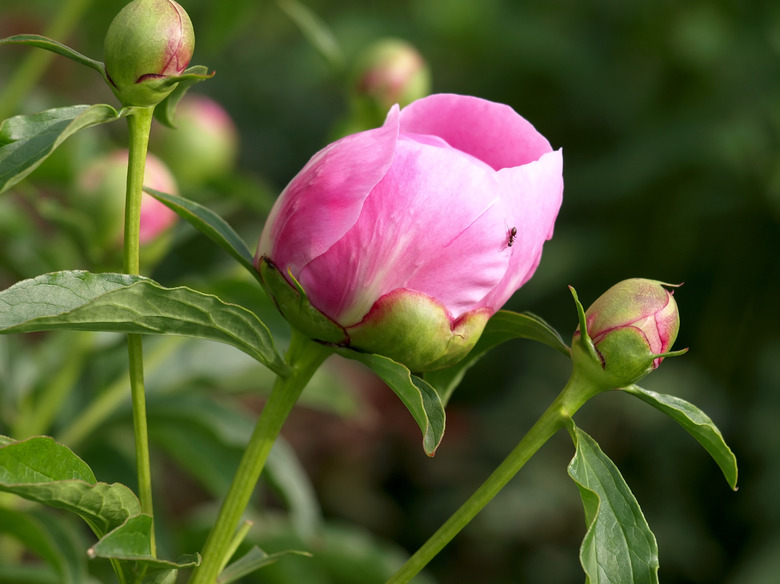When To Transplant Peonies?
The root clumps of garden peonies (Paeonia officinalis) are typically divided and transplanted after the plants go dormant in late summer or early autumn. While it is technically possible to transplant them in spring or in summer before they go dormant, transplanting in those times is not recommended and seldom practiced because success is unpredictable and the flowering takes two to three years longer.
Peony Species
Garden peonies are herbaceous perennial shrubs that grow from 24 to 36 inches tall in U.S. Department of Agriculture plant hardiness zones 3b through 8a. Peonies need winter cold to yield flowers.
Since peonies have a productive life of 25 years or longer, select a permanent site that gets lots of sun. Peonies like soil with a pH of 6 to 7. It should be well-drained to prevent their roots from rotting.
A garden peony root division useful for transplant will have three to five "eyes," buds that resemble pink noses. These will develop into shoots for the next spring to autumn growing season. A division with only one or two eyes will typically take from three to five years to flower after you transplant it.
Transplanting Time
Peonies go dormant in late August to early September, depending on local climate. When peonies go dormant their flowers wilt and their foliage dries up. When that happens, transplant them as soon as possible, giving the soil time to settle before a hard freeze can buckle the ground.
If a peony is dead in the center or has stopped producing flowers, it's time to divide it and transplant the divisions. Sometimes growing trees will shade a peony. When this happens, divide the roots and transplant the divisions in a sunny location.
Dividing Root Clumps
Divided peony roots are not typically stored. They're planted immediately after they're divided. Smaller garden peony root divisions take longer to flower than larger divisions. It's easiest to divide the root clump of a 2-year-old garden peony, although you can also divide 3-year-old roots. After that the roots become so large and intertwined that dividing them is difficult.
Sterilize a sharp knife by soaking it for five minutes in a solution of 1 part household bleach to 3 parts of water, then air dry. Cut the leaves and stems to the ground first, then dig up its root clump. Be careful not to break the roots.
To avoid cutting the roots when you remove the plant from the ground, use a spade to dig 3 to 4 inches straight down in a circle 8 to 10 inches from the peony stems, then repeat the circle with the spade angled inward so you cut at least 6 inches below the roots.
Wash the soil off the roots. Divide the roots into 4-to 6-inch fleshy stubs, each containing three to five eyes, and eliminate the small roots that resemble threads.
Preparing the Soil
Dig a hole 18 inches wide and 12 to 18 inches deep. Incorporate a 2- to 4-inch layer of well-aged manure, pine bark or compost into the soil that you removed. Place 1/4 to 1/2 cup of 10-10-10 fertilizer on the bottom. Place half of the amended soil in the hole and put the transplant on top of that, filling with the remainder of the soil. Alternatively, work compost about 12 inches into the soil before transplanting.
Either method of soil amendment will provide necessary nutrients for transplanted roots to get established. You won't have to fertilize the peony again until it's large enough to yield flowers.
Transplanting Basics
The uppermost fleshy eyes of a divided root transplant should face up and be within 2 inches of the surface. If you plant them deeper, the peony will produce leaves but no blossoms. Tamp the soil down and water well when you're finished.
Cover the transplant with a 2- to 3-inch layer of organic mulch. Do not apply mulch any deeper because keeping them too warm might prevent them from flowering the next spring.
References
- Iowa State University Extension: How to Transplant Peonies
- North Carolina State University Extension: Peonies for the Home Landscape
- Kansas State University Extension: Peonies
- Zipcodezoo: Paeonia Officinalis
- Zipcodezoo: Paeonia Suffruticosa
- University of Florida IFAS Extension: Disinfecting Pruning Tools
